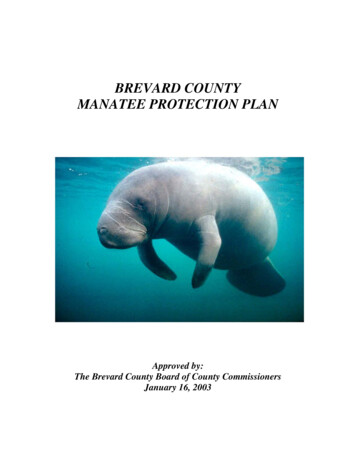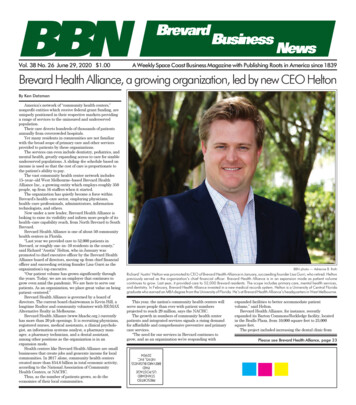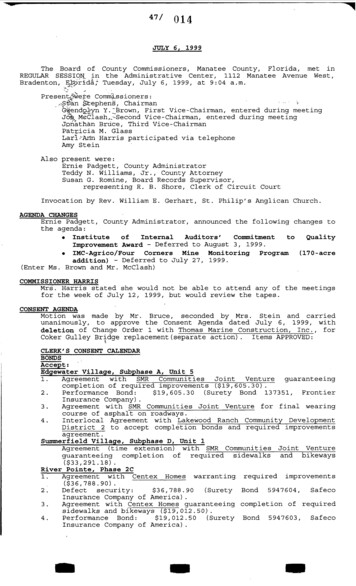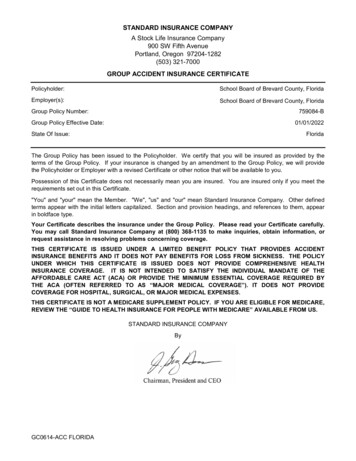
Transcription
BREVARD COUNTYMANATEE PROTECTION PLANApproved by:The Brevard County Board of County CommissionersJanuary 16, 2003
TABLE OF CONTENTSLIST OF FIGURES . ivLIST OF TABLES . viLIST OF APPENDICES . viiEXECUTIVE SUMMARY . viiiI. INTRODUCTION . 11PURPOSE . 11GOAL . 11OBJECTIVE . 11OVERVIEW . 11II. RECOMMENDATIONS. 15A. HABITAT PROTECTION . 15B. COUNTY MANATEE SANCTUARY RESOLUTION . 19C. BOAT FACILITY SITING . 19D. MANATEE PROTECTION BOAT SPEED ZONES . 30E. MANATEE ZONE SIGN MAINTENANCE . 31F. MOORING BUOYS . 31G. NAVIGATION CHANNEL MARKINGS . 31H. CAUSEWAYS AND RELIEF BRIDGES . 31I. MAINTENANCE DREDGING PROJECTS . 31J. LAW ENFORCEMENT RECOMMENDATIONS . 32K. PROBLEM HUMAN INTERACTION AREAS . 32L. WAYS TO REDUCE OTHER CAUSES OF MANATEE MORTALITY . 32Canal Locks . 32Pesticides and Herbicides. 32Conveyance Structures . 33Monofilament Line . 33Crab Trap Lines. 33M. PORT CANAVERAL SPECIAL PLANNING AREA . 33N. EDUCATION INITIATIVE . 35Existing Educational Programs. 35Recommended Educational Programs. 35Education Initiative Implementation Recommendations . 44O. WATERSPORTS AREAS . 44P. RESEARCH . 45Power Plants: . 45Manatee Mortality: . 45i
TABLE OF CONTENTSQ. CANAL WATER QUALITY . 45R. LIVEABOARDS . 45S. MPP RE-EVALUATION POLICY . 46T. IMPLEMENTATION SCHEDULE FOR MPP 48III. INVENTORY AND ANALYSIS. 47A. THE FLORIDA MANATEE . 471. Natural History . 482. Physical Characteristics . 483. Diet. 524. Social Behavior. 525. Reproduction. 536. Longevity. 547. Habitat Requirements . 54B. MANATEE DISTRIBUTION AND ABUNDANCE . 541. U.S. Distribution . 602. Florida Distribution. 603. Brevard County Distribution . 604. Telemetry Studies . 625. Abundance Studies . 64C. PRESENT THREATS TO MANATEES . 711. Activities directly resulting in mortality and/or serious injury. . 712. Activities affecting reproduction and recruitment. 713. Activities that alter distribution and behavior. 724. Activities that directly and indirectly impact vegetation and water quality. 725. Activities that increase contaminant and pathogen levels. 736. Activities that influence the condition, availability of warm water refugia. . 73D. ANALYSIS OF MANATEE MORTALITY DATA . 741. Causes of Manatee Mortality. 77E. MANATEE LEGISLATION AND PROTECTION . 911. Federal Protection. 912. State Protection. 923. Objectives for County Protection Plans . 924. County Protection . 925. Manatee Protection Boat Speed Zones. 936. Boating Safety and Property Protection Boat Speed Zones . 115F. LAW ENFORCEMENT . 115G. HABITAT ISSUES. 1171. Seagrass Protection and Management . 1172. Manatee Protection/Regulatory Signs . 1183. Water Quality Concerns . 1184. Availability of Warm Water Refugia. 119TABLE OF CONTENTSii
H. EXISTING BOATING FACILITIES . 1211. Port Canaveral . 1212. Other Commercial Boat Facilities. 1223. Marinas . 1224. Boat Ramps . 1305. Multi-slip Docks and Single Family Docks . 1356. Boat Rental Facilities . 1357. Temporary Moorings Facilities . 1368. Watersports Areas. 137I. BREVARD COUNTY BOATING ACTIVITY PATTERNS . 139J. INVENTORY OF PRESENT MANATEE EDUCATIONAL PROGRAMS . 141iii
LIST OF FIGURESFigure 1.Location of Brevard County, Florida13Figure 2.World-Wide Distribution of Modern Sirenians50Figure 3.Physical Characteristics of Florida Manatees51Figure 4.Significant Freshwater Sources for Manatees in Brevard County,Florida56Figure 5a.1994 Submerged Aquatic Vegetation (SAV) Coverage in NorthBrevard County57Figure 5b.1994 Submerged Aquatic Vegetation (SAV) Coverage in CentralBrevard County58Figure 5c.1994 Submerged Aquatic Vegetation (SAV) Coverage in SouthBrevard County59Figure 6a.Manatee Aerial Survey Data in North Brevard County, Florida68Figure 6b.Manatee Aerial Survey Data in Central Brevard County, Florida69Figure 6c.Manatee Aerial Survey Data in South Brevard County, Florida70Figure 7.Total Manatee Mortality among the 13 “Key” Counties (1974-2001)75Figure 8.Trend Analysis of Manatee Mortality in Florida (1976-2001).Watercraft Mortality vs. Vessel Registration76Figure 9a.Manatee Mortality by Category in North Brevard County, Florida(1974-2001)81Figure 9b.Manatee Mortality by Category in Central Brevard County, Florida(1974-2001)82Figure 9c.Manatee Mortality by Category in South Brevard County, Florida(1974-2001)83Figure 10a.Watercraft-related Mortality in North Brevard County, Florida (19742001)84Figure 10b.Watercraft-related Mortality in Central Brevard County, Florida(1974-2001)85Figure 10c.Watercraft-related Mortality in South Brevard County, Florida (19742001)86Figure 11.Human-related Manatee Mortality among the 13 “Key” Counties(1974-2001)87Figure 12.Federal Motorboat Prohibited Zone, North Banana River94Figure 13.Federal Manatee Refuge, Haulover Canal95Figure 14.Federal Manatee Refuge, Barge Canal97Figure 15.Federal Manatee Refuge, Sykes Creek98Figure 16.Federal Manatee Refuge, Cocoa Beach99iv
LIST OF FIGURESFigure 17.State Manatee Speed Zones in the Mosquito Lagoon and the NorthIndian River (Turnbull Basin)101Figure 18.State Manatee Speed Zones in the North Indian River (Titusville toS.R. 528)103Figure 19.State No Entry and Motorboat Prohibited Zones in the North IndianRiver104Figure 20.State Manatee Speed Zones in the Central Indian River, North BananaRiver, Barge Canal, and Sykes Creek108Figure 21.State Manatee Speed Zones in the Central Indian River (S.R. 404 toCape Malabar) and the South Banana River109Figure 22.State Manatee Speed Zones in the South Indian River and theSebastian River110Figure 23.Class II Waters, Outstanding Florida Water’s, and Aquatic Preserves120Figure 24.Marinas in Brevard County, Florida - 1994124Figure 25.Vessel Registrations in Brevard County. Projected to the Year 2006129Figure 26.Boat Ramps in Brevard County, Florida - 1994132v
LIST OF TABLESTable 1. Manatee Distribution by Geographic Area in Brevard County, Florida67Table 2. Total Manatee Mortality in Florida by Year and Category (1974-2001)79Table 3. Manatee Mortality by Year and Category in Brevard County (1974-2001)80Table 4. Seasonal Analysis of Manatee Mortality in Brevard County (1974-2001)88Table 5. Manatee Regulation Enforcement116Table 6. Marinas in Brevard County, Florida - 1994126Table 7. Boat Ramps in Brevard County, Florida - 1994133Table 8. Restaurants with Temporary Mooring Slips in Brevard County - 1994137vi
LIST OF APPENDICESAppendix 1:Glossary150Appendix 2:158Appendix 5:Resolution Revising the Brevard County Manatee SanctuaryResolution of 1976. Adopted August 26, 1976Brevard County Comprehensive Plan Policies and OrdinancesRelating to Manatee ProtectionIndian River Lagoon Conservation and Management Plan HabitatProtection RecommendationsManatee Protection Plan Ad-hoc Committee MembershipAppendix 6:Manatee Habitat Features Map Series and Update SchedulesAppendix 3:Appendix 4:vii161200227231
EXECUTIVE SUMMARYFlorida is third in the United States, behind Hawaii and California, in having the largest numberof endangered and threatened species listed by the U.S. Fish and Wildlife Service (USFWS{Endangered Species Act}). For many of these Florida animal and plant species, BrevardCounty’s location along the east-central coast of Florida provides optimal weather and habitatsfor their populations to grow and reproduce. The Indian River Lagoon’s watershed also harborsmore endangered and threatened species than any other area of Florida. One of the most wellknown and popular of these listed species in Florida is the endangered Florida manatee(Trichechus manatus latirostris).Brevard’s weather and natural settings attract many people to relocate to this area permanently,and draws tourists by the thousands to its beaches and estuaries. The Indian River Lagoon inBrevard affords ideal opportunities for commercial and recreational fishing, boating, and otherwater sports. The presence of a warm water refuge, ample seagrass beds for forage, andprotected areas in the north Banana River also make Brevard County attractive habitat formanatees. In fact, Brevard County has been described as the hub of the east coast manateepopulation with both a large year-round and migratory transient manatee population presentthroughout the year. The largest spring and winter manatee aggregations in the state of Floridahave been recorded in Brevard County. Spring aggregations in the north Banana River alonehave exceeded 365 manatees, while winter surveys at Brevard’s warm water refuges havedocumented at least 529 manatees.From June of 1974 through 2001, there were 4,367 manatee mortalities documented in Florida.Of the 4,367 total manatee mortalities 1,069 were a result of watercraft collisions.Approximately 19% (835) of the manatee mortalities recovered in Florida were from BrevardCounty waters. Human-related causes of death include: watercraft collisions, deaths due towater control structures, ingested debris, and entanglement in fishing line or marine debris. Ofthe manatee mortalities recovered from Brevard County from June 1974-2001, 29% (243) wereundetermined, 27% (229) were attributed to perinatal mortality, 23% (191) were attributed towatercraft collisions, 11% (92) were attributed to other natural causes, 5% (49) were attributedto natural cold stress, 2% (17) were attributed to other human causes, and 2% (14) wereattributed to flood gate/canal locks. For the majority of manatee mortalities recorded as“undetermined,” the manatee carcass was too badly decomposed to make any determination as tothe cause of death.This many human-related deaths and human activity related impacts to manatee habitat,combined with the manatee’s slow reproductive rate, contributes to the Florida manatee being injeopardy of extinction. Protection and recovery of the Florida manatee population focusesprimarily on the short-term goal of reducing human-related manatee mortality and the long-termgoal of protecting manatee habitat, but does not focus on the major causes of manatee mortality,namely disease, hypothermia, pollution, and perinatal (calf) death.The escalating problems associated with manatees being killed by boats led the Governor andCabinet on October 24, 1989, to approve recommendations for protecting the manatee and itshabitat, and increasing boating safety in the state’s waterbodies. The state recognized thirteencoastal counties, including Brevard County, as being important for the manatee’s survival. Inviii
EXECUTIVE SUMMARYearly 1993, the state agreed to help Brevard County’s manatee protection efforts by funding thedevelopment of a species management plan that included as its primary purpose maintaining aviable manatee population. This was to be accomplished through the protection andrehabilitation of its habitat, enhanced boating regulation, the development of a boat facility sitingplan, and the development of a manatee education program.A major objective of this plan was to allow a level of reasonable use of the lagoon by Brevard’spower boaters, while still maintaining the overall goal of manatee protection. On May 5, 1993,the Florida Department of Environmental Protection (FDEP), and the Brevard County Board ofCounty Commissioners entered into a contract to develop the Manatee Protection Plan (MPP).(Note: manatee protection, and the Bureau of Protected Species Management were shifted to thereorganized Florida Fish and Wildlife Conservation Commission (FWC) in 1999).During the early contract negotiations, both the FDEP and Brevard County recognized that allparties with interests in the Indian River Lagoon must be active participants in developing aspecies protection plan for it to have any chance of success. To insure a broad basedparticipation in the development of the MPP, representatives of the following groups wereincluded: all municipalities bordering the lagoon, Port Canaveral, Patrick Air Force Base, theSebastian Inlet Commission, boating, law enforcement, commercial fishing, the marine industry,environmental groups, and Federal and State agencies involved with manatee protection.In addition to the creation of a management plan by the MPP Management Ad-Hoc Committee(MPPMAHC), the contract also stipulated the development of an educational program byrepresentatives of the environmental and education communities and boating awareness groupssuch as the U.S. Power Squadron and Marina industry. The MPP Education Ad-Hoc Committee(MPPEAHC) was charged with designing manatee education materials targeted at all interestgroups in Brevard.Representatives of the MPPMAHC (34 members) and the MPPEAHC (13 members) met over aperiod of two and one half years in an effort to accomplish the goals and objectives of the MPP.The Committee’s membership lists are included in Appendix 5. The final MPP produced by thiseffort is a two part report that presents the MPPMAHC recommendations including: A brief description and history of the manatee in FloridaReducing threats to the manatee’s survival including habitat loss, support forexisting and new legislation, and enhanced law enforcementBoating and boat facility siting issuesHabitat preservation and enhancement measuresThe second part of the MPP includes 20 education recommendations and initiatives developedby the MPPEAHC. These include: Provide boat speed zone maps and brochures with boat registrationsInclusion of manatee information in boating safety coursesPublic service announcements, workshops, and education programsix
EXECUTIVE SUMMARY Public displays, including kiosks, signs, computer bulletin boards, and newspaperannouncementsThe recommendations included in this plan do not pertain to the St. Johns River as there is nodata documenting regular or frequent manatee use of the St. Johns River in Brevard County.Our goal is to provide for direction and management of our waterways, ensuring that BrevardCounty is 100 % compliant with the Florida Manatee Sanctuary Act (370.12 FS).To the extent that this plan proposes, or describes, or implicates changes to the County’s LandUse Regulations or Comprehensive Plan, the adoption of this MPP shall not serve as nor committhe County to make such changes.Rather, the Board of County Commissioners shall undertake appropriate public hearings toconsider such changes, and shall only adopt such changes if determined that it is in the public’sbest interest. Further, nothing in this plan requires the Board of County Commissioners to spendtax dollars on improvements recommended or described unless a specific fund for constructionor purchase is designated.x
I. INTRODUCTIONPURPOSEOn October 24, 1989, the Governor and Cabinet approved recommendations submitted by theFlorida Department of Environmental Protection (now the Florida Fish and WildlifeConservation Commission, FWC) to protect the manatee and its habitat and to increase boatingsafety in the state's waterways. In these recommendations, thirteen key counties with high levelsof manatee mortality, including Brevard County, were identified, but not mandated, to developcomprehensive management plans to reduce manatee mortality and establish boat facility sitingpolicies.The purpose of Brevard County's Manatee Protection Plan (MPP) is to present a summary ofexisting information about the Florida manatee (Trichechus manatus latirostris), a subspecies ofthe West Indian manatee, in Brevard County and to develop a strategy that when implementedwill equitably balance endangered species issues, resource protection, water resource uses, andboating safety. The principal focus of this effort is the identification and implementation ofprotection and management practices necessary to ensure the survival of the Florida manatee.The plan will address issues such as: identification and protection of manatee habitat, boatfacility siting and design standards, manatee protection boat speed zones, development ofmanatee awareness, and educational materials and workshops. Additionally, recommendationsfor important land acquisitions, enhanced coordination and sensitization of law enforcementagencies, and intergovernmental coordination initiatives will be included.GOALThe goal of this plan is to protect the manatee and its habitat and to increase boating safety inBrevard County.OBJECTIVEThe objective of this plan is to allow for reasonable recreational and commercial use in thecoastal zone consistent with the protection of manatees.OVERVIEWBrevard County is located on the central east coast of Florida, and is approximately 72 mileslong (north-south) and 20 miles wide, with over one-quarter of its total area consisting of water(Figure 1). The county is bordered on the east by the Atlantic Ocean and on the west by thenorth-flowing St. Johns River. A short distance inland of the Atlantic Ocean lies the IndianRiver Lagoon (IRL) System, an expansive complex of three bar-bounded estuarine lagoons (theMosquito, Banana, and Indian River Lagoons). This estuarine system is reported as being one ofthe most diverse estuaries in North America (Gilmore et al. 1985, Fernald et al. 1982). The sub11
tropical Eastern Caribbean and the temperate Carolinian biogeographic zones converge nearCape Canaveral. The convergence plays a role in the diversity of this unique region. BrevardCounty is also home to one of the largest aggregations of Florida manatees (Trichechus manatuslatirostris) in the state (FDEP 1992, Jane Provancha, personal communication, Marine MammalCommission 1988). Sub-tropical seagrass meadows, the primary food source for manatees inBrevard, reach the northern extent of their range on the Atlantic coast within this ecotone.Historically, the majority of manatees on the east coast of Florida were believed to be limited intheir distribution during cold winters to the warmer sub-tropical waters south of the SebastianRiver (Moore 1951). Because of their limited ability to conserve heat, manatees cannot surviveexposure to water temperatures below approximately 68 degrees Fahrenheit (20 C) for extendedperiods of time (Marine Mammal Commission 1988). In north and central Florida, winter watertemperatures will periodically drop below 68 degrees for short periods. During these periods,manatees will seek out warm water sources. The construction of power plants and otherindustries that discharge large volumes of warm water into Florida’s coastal bays and estuariesprovide manatees with warm water refuge areas (Campbell and Irvine 1981, O’Shea et al. 1985).Since the introduction of these warm water sources, more manatees use Brevard County watersduring winter months.With the presence of a warm water refuge, ample forage, and protected areas in the north BananaRiver, Brevard County hosts a significant year-round manatee population. Spring and winteraggregations are the largest documented in the State. Spring aggregations in the north BananaRiver, alone, have exceeded 365 manatees (Jane Provancha, personal communication), whilewinter surveys at Brevard’s warm water refuges (during cold fronts) have documented at least529 manatees (Bruce Ackerman, personal communication).Brevard County also has the highest number of manatee mortalities, including the highestnumber of watercraft-related manatee mortalities, of any county in the State. From 1991-1997the synoptic survey numbers recorded by the State ranged from 51-581 manatees counted inBrevard County. From June of 1974-2001, there were 4,367 manatee mortalities documented inFlorida. Of these, approximately 19% (835) were recovered from Brevard County waters.Manatee mortalities are divided into seven major categories: “Watercraft,” “Flood Gate/CanalLock,” “Other Human,” “Perinatal,” “Other Natural,” “Natural Cold Stress,” and“Undetermined.” Human-related causes of death include: watercraft collisions, deaths due towater control structures, ingested debris, and occasional human inflicted injuries or poaching.Of the manatee mortalities recovered from Brevard County from 1974-2001, 29% (243) wereundetermined, 27% (229) were attributed to perinatal mortality, 23% (191) were attributed towatercraft collisions, 11% (92) were attributed to other natural causes, 5% (49) were attributedto natural cold stress, 2% (17) were attributed to other human causes, and 2% (14) wereattributed to flood gate/canal locks. For the majority of manatee mortalities recorded as“Undetermined,” the manatee carcass was too badly decomposed to make any determination asto cause of death (Donna Banowitz, Marine Mammal Pathobiology Lab, personalcommunication).12
13
Many of the “Other Natural” manatee mortalities are attributed to cold stress (FDEP 1995a).Power plant discharges provide a critical warm water refuge for manatees during cold weatherevents. However, the ability of the discharge to raise the surrounding water temperature islimited. Manatees that remain at the warm water refuges in Brevard may still be susceptible tocold stress during prolonged and/or severe cold periods. During the 1989-1990 winter season,record low temperatures over an extended period of time in conjunction with reduced warmwater discharge from the power plants (due to repairs) resulted in 31 cold stress mortalities(FDEP 1995a). The USFWS has accepted MPP’s for both the Reliant Energy CorporationIndian River Plant and the Florida Power and Light Corporation (FPL) Cape Canaveral Plant.These MPP’s will help to prevent the reduction of available warm water during winter months inthe future (Jim Valade, USFWS, personal communication).A major threat to the long-term survival and recovery of the manatee population is loss of habitat(USFWS 1995). Brevard County has experienced rapid population growth since thedevelopment of the Kennedy Space Center in the mid-1960's. Most of this growth isconcentrated along the shores of the IRL and the Atlantic barrier islands. As the humanpopulation grew, the seagrass beds in the nearby IRL declined. Extensive development withpoor soil conservation practices, stormwater runoff, and the discharge of a large volume ofwastewater into surface waters has, over time, degraded the water quality of t
plan, and the development of a manatee education program. A major objective of this plan was to allow a level of reasonable use of the lagoon by Brevard's power boaters, while still maintaining the overall goal of manatee protection. On May 5, 1993, the Florida Department of Environmental Protection (FDEP), and the Brevard County Board of










